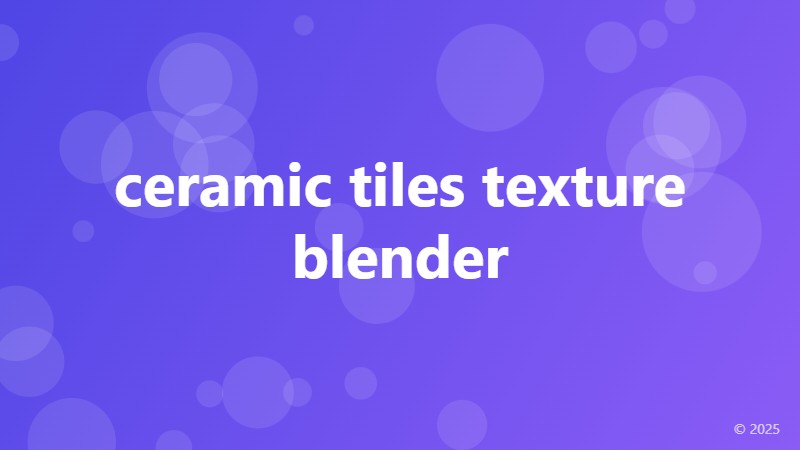ceramic tiles texture blender

Unlocking the Secrets of Ceramic Tiles Texture in Blender
When it comes to creating realistic 3D models and scenes, textures play a crucial role in adding depth and visual appeal. Ceramic tiles, in particular, can be a challenging material to replicate in Blender, but with the right techniques and tools, you can achieve stunning results. In this article, we'll delve into the world of ceramic tiles texture in Blender and explore the best practices for creating realistic and detailed textures.
Understanding Ceramic Tiles Texture
Ceramic tiles are known for their unique texture, which is often characterized by a combination of glossy and matte finishes, subtle color variations, and intricate patterns. To replicate this texture in Blender, it's essential to understand the physical properties of ceramic tiles and how they interact with light. By studying reference images and observing the way ceramic tiles behave in real-life scenarios, you can gain a better understanding of the texture and create a more accurate representation in your 3D model.
Preparing Your Blender Scene
Before you start creating your ceramic tiles texture, it's essential to set up your Blender scene correctly. Start by creating a new material and assigning it to your 3D model. Then, create a new texture and set it to "Image or Movie" to enable texture painting. You can also set up a reference image in the background to help guide your texture creation process.
Creating a Realistic Ceramic Tiles Texture
To create a realistic ceramic tiles texture in Blender, you'll need to combine multiple texture layers and manipulate them using various tools and techniques. Here's a step-by-step guide to get you started:
1. Start by creating a base color layer using a solid color or a subtle gradient. This will serve as the foundation for your ceramic tiles texture.
2. Add a noise texture layer to create subtle variations in color and texture. You can use the "Noise" texture node in Blender to generate a natural-looking noise pattern.
3. Use the "Bump" texture node to add depth and dimension to your ceramic tiles texture. This will help create a more realistic representation of the material.
4. Add a specular texture layer to control the level of glossiness and reflectivity. This is particularly important for ceramic tiles, which often have a mix of glossy and matte finishes.
5. Use the "Mix" texture node to combine your texture layers and control the overall look and feel of your ceramic tiles texture.
Tips and Tricks for Achieving Realism
To take your ceramic tiles texture to the next level, here are some additional tips and tricks to keep in mind:
1. Study reference images and observe the way ceramic tiles behave in real-life scenarios.
2. Experiment with different texture layers and techniques to achieve a unique and realistic look.
3. Pay attention to the scale and resolution of your texture to ensure it looks crisp and detailed in your 3D model.
4. Use the "Texture Paint" tool in Blender to add subtle details and nuances to your ceramic tiles texture.
By following these tips and techniques, you can create a stunning and realistic ceramic tiles texture in Blender that will elevate your 3D models and scenes to the next level.